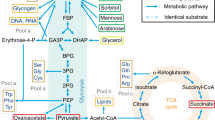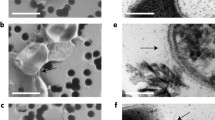Summary
As the macromolecular composition of microorganisms varies during their life cycle it was asked whether, and to what extent such changes exert any influence on substrate consumption, i.e. growth yield and carbon conversion efficiency, respectively. This question was dealt with in a theoretical study by use of the Y maxAPT -concept. The growth substrates considered were methanol, acetate and glucose; the latter was assumed to be assimilated via both the glycolytic and the oxidative hexosemonophosphate pathway. Five fictitious biomasses were used which were altered in their proportion of polysaccharides, proteins, lipids, RNA and DNA. As a result, only small variations in the individual “biomass formulae” were obtained. On the basis of the energy balances for the syntheses of all cell constituents it was found that variations in the macromolecular composition of microbial biomass have only a slight effect on carbon conversion efficiency, amounting to maximally 3%. From the material balances it could be calculated that the upper, solely metabolism-determined limit of carbon conversion efficiency is 85% for substrates assimilated glycolytically via phosphoglycerate; for gluconeogenetic substrates, the upper limit was 75%. These limits are essentially determined by carbon loss on the way to amino acid syntheses.
Similar content being viewed by others
Abbreviations
- Ac:
-
acetate
- CCE:
-
carbon conversion efficiency (%)
- EMP:
-
Embden-Meyerhof-Parnas (glycolytic) pathway
- Gluc:
-
glucose
- HMP:
-
oxidative hexosemonophosphate pathway
- m e :
-
maintenance coefficient (mmol g-1 h-1)
- MeOH:
-
methanol
- PGA:
-
phosphoglycerate, Y, growth yield (g dry weight per g substrate)
- Y ATP :
-
growth yield (g dry weight per mole ATP)
- μ:
-
specific growth rate (h-1)
References
Anthony C (1978) The prediction of growth yields in methylotrophs. J Gen Microbiol 104:91–104
Babel W (1979) Bewertung von Substraten für das mikrobille Wachstum auf der Grundlage ihres Kohlenstoff/Energie-Verhältnisses. Z Allg Mikrobiol 19:671–677
Babel W (1980) Mischsubstratfermentation — ein energetisch begründetes Konzept. Acta Biotechnol 61–64
Babel W (1982) Energetische Grundlagen und biochemische Aspekte der Mischsubstratfermentation. In: Abhandlungen Akad Wiss DDR, N2 “Biotechnologie”. Akademie-Verlag, Berlin, pp 183–188
Babel W, Müller RH (1985a) The influence of carbon catabolism on the auxiliary substrate effect. Acta Biotechnol, in press
Babel W, Müller RH (1985b) Mixed substrate utilization in micro-organisms: biochemical aspects and energetics. J Gen Microbiol 131:39–45
Babel W, Müller RH, Markuske KD (1983) Improvement of growth yield of yeast on glucose to the maximum by using an additional energy source. Arch Microbiol 136:203–208
Dekkers JGJ, DeKok HE, Roels JA (1981) Energetics of Saccharomyces cerevisiae CBS 426: comparison of anaerobic and aerobic glucose limitation. Biotechnol Bioeng 23:1023–1035
Van Dijken JP, Harder W (1975) Growth yields of microorganisms on methanol and methane. A theoretical study. Biotechnol Bioeng 17:15–30
Harder W, van Dijken JP (1976) Theoretical considerations on the relation between energy production and growth on methane-utilizing bacteria. In: Schlegel HG, Gottschalk G, Pfennig N (eds) Microbial production and utilization of gases. E Goltze KG, Göttingen, pp 403–418
Heinritz B, Bley T, Rogge G, Stichel E, Ringpfeil M (1984) Dynamic processing in biotechnical systems. Acta Biotechnol 4:275–278
Jones EW, Fink GR (1982) Regulation of amino acid and nucleotide biosynthesis in yeast. In: Cold Spring Harbor Monogr Ser, vol 11B, pp 181–299
Lebeault JM (1979) Alkanes and highly reduced substrates for bacterial and yeast growth. In: Dechema Monographie 83, No 1704-1723. Verlag Chemie, Weinheim, pp 135–145
Müller RH, Babel W (1984) Glucose as an auxiliary substrate. The influence of its carbon catabolism on the maximum carbon conversion efficiency. Appl Microbiol Biotechnol 20:195–200
Oura E (1983) Formation of biomass from carbohydrates. In: Rehm HJ, Reed G (eds) Biotechnology, vol 3, Dellweg H (ed). Verlag Chemie, Weinheim, Deerfield/Florida, Basel, pp 4–41
Rattray JBM, Hambleton JE (1980) The lipid components of Candida boidinii and Hansenula polymorpha grown on methanol. Can J Microbiol 26:190–195
Roels JA (1980) Application of macroscopic principles to microbial metabolism. Biotechnol Bioeng 22:2457–2514
Stouthamer AH (1973) A theoretical study on the amount of ATP required for the synthesis of microbial cell material. Antonie van Leeuwenhoek 39:545–565
Stouthamer AH (1977) Energetic aspects of the growth of micro-organisms. In: Symp Soc Gen Microbiol, XXVII Microbial Energetics, pp 285–315
Stouthamer AH (1979) The search for correlation between theoretical and experimental growth yields. In: Quayle JR (ed) International Rev Biochemistry, “Microbial Biochemistry”, vol 21. University Park Press, Baltimore, pp 1–47
Author information
Authors and Affiliations
Rights and permissions
About this article
Cite this article
Babel, W., Müller, R.H. Correlation between cell composition and carbon conversion efficiency in microbial growth: a theoretical study. Appl Microbiol Biotechnol 22, 201–207 (1985). https://doi.org/10.1007/BF00253610
Received:
Revised:
Issue Date:
DOI: https://doi.org/10.1007/BF00253610




